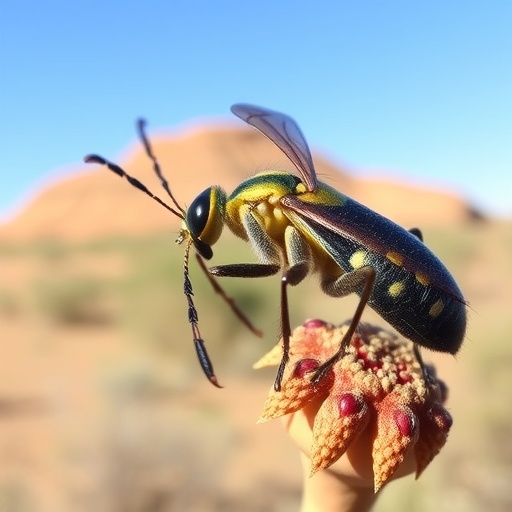In an expansive study scrutinizing the intricate web of life under our feet, researchers have unveiled profound insights into the abundance and diversity of crawling insects across five distinct land-use types in a semi-arid region. This pivotal research, led by a team of experts including Mmbaga, N.E., Johnson, J.A., and Nnko, H.J., shines a spotlight on the oft-overlooked, yet critically vital role that these minute creatures play in maintaining ecological balance and promoting biodiversity. The findings could reshape our understanding of land use management and biodiversity conservation strategies in similar environments.
Crawling insects, often dismissed as nuisances, are foundational elements of ecosystems. These organisms perform essential functions such as pollination, decomposition, and soil aeration. By analyzing various land uses—ranging from agricultural fields to natural reserves—the study lays bare how human intervention alters not only the composition of insect communities but also their functions within these ecosystems. This research addresses a gap in our understanding of how diverse land use impacts the insect populations that play pivotal roles in our environment.
The semi-arid region selected for the study provides a microcosm of the challenges faced by ecosystems worldwide, driven as they are by agricultural expansion, urban development, and climate change. The researchers meticulously collected samples from five different land-use types. Each site provided a unique snapshot of the local biodiversity, and by comparing these snapshots, the researchers could identify patterns and trends reflective of broader ecological shifts. The variations in insect populations across the land-use types illustrate important lessons about habitat preservation and restoration.
Notably, the findings highlight the dramatic differences in insect abundance and diversity across these land use types. In highly managed agricultural plots, the number of crawling insects might significantly decrease when compared to more natural or less disturbed areas. This can have cascading effects on the ecosystem, disrupting food webs and leading to a decline in ecosystem services. The results underscore the importance of integrating biodiversity considerations into land management practices to mitigate adverse effects on insect populations.
One of the key revelations of the study is the relationship between community awareness and insect diversity. The researchers found that areas where the local community was more engaged in conservation efforts exhibited higher levels of insect diversity and abundance. This finding emphasizes the critical role of public education and community involvement in biodiversity conservation. As awareness grows, so too does the collective responsibility toward preserving local ecosystems and the myriad species they support.
To further translate these findings into actionable outcomes, the researchers recommended developing community-led initiatives aimed at promoting sustainable land practices. Public programs that emphasize the value of crawling insects to ecosystem health and agricultural productivity could empower communities to adopt practices that facilitate both biodiversity and sustainable livelihoods. The researchers propose that enhanced education and practical workshops could lead to more informed decisions concerning land use and conservation efforts.
Moreover, understanding the ecological roles of crawling insects is essential for predicting future changes in biodiversity in response to climate change and anthropogenic pressures. As temperatures rise and weather patterns shift, the resilience of these communities becomes increasingly important. The findings from this research serve as a clarion call for further studies that explore how climatic variations might influence insect populations and, consequently, ecosystem functionality and health.
The research also emphasizes the necessity of interdisciplinary approaches in studying insect communities and their interactions with the environment. By integrating fields such as ecology, entomology, and social science, researchers can gain a more comprehensive understanding of the factors that affect biodiversity. This holistic view is essential for crafting effective conservation strategies that address not only the ecological aspects but also the socio-economic dynamics at play.
In summary, Mmbaga, N.E. and colleagues’ study provides invaluable insights into the complex dynamics of crawling insects and their habitats. It highlights the interplay between land use practices, community engagement, and biodiversity conservation, thus offering critical implications for policymakers and land managers. As we strive to balance economic development with environmental stewardship, the role of insects in our ecosystems should no longer be overlooked.
In the face of increasing urbanization and agricultural intensification, the findings underscore the urgent need to rethink our relationship with nature. Preserving crawling insect habitats is not merely an ecological concern; it is vital for human sustainability and resilience. The call to action is clear: fostering an awareness of the roles of insects can pave the way for more sustainable land-use practices and better outcomes for both people and the planet.
This research illuminates a path forward, positioning local communities as pivotal players in the conservation narrative. By spotlighting the connection between insect diversity and community action, it lays the groundwork for a more collaborative and effective approach to environmental conservation.
Ultimately, as we move forward in a world that is rapidly changing, the insights garnered from this study will resonate, encouraging a deeper appreciation for the myriad forms of life that exist around us and the crucial roles they play in the health of our ecosystems.
Subject of Research: The abundance, diversity, and community awareness of crawling insects across various land use types in a semi-arid region.
Article Title: Abundance, diversity, and community awareness of crawling insects across five land use types in a semi-arid region.
Article References:
Mmbaga, N.E., Johnson, J.A., Nnko, H.J. et al. Abundance, diversity, and community awareness of crawling insects across five land use types in a semi-arid region.
Discov Anim 2, 55 (2025). https://doi.org/10.1007/s44338-025-00111-9
Image Credits: AI Generated
DOI: 10.1007/s44338-025-00111-9
Keywords: Crawling insects, biodiversity, land use, community awareness, semi-arid region, ecological roles, environmental conservation.




